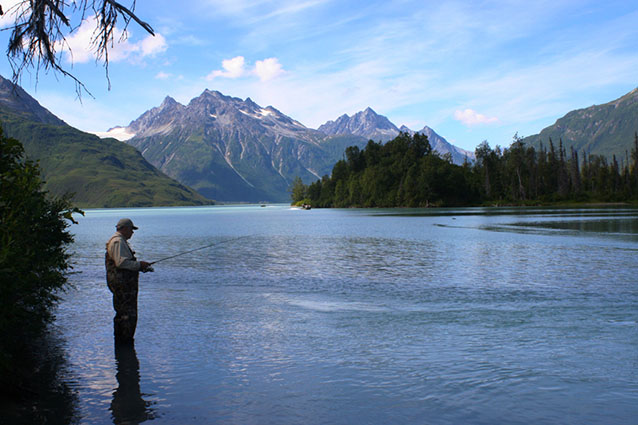Proper catch and release fishing methods increase the chances of survival for the fish you choose not to keep.

NPS Photo / Lake Clark National Park and Preserve / Megan Richotte
Why Catch and Release?
The National Park Service strives to maintain park resources in a natural, unaltered condition. Native fish contribute to nutrient recycling and help maintain natural ecosystem processes when they live out their entire life cycle, from spawning to death, in the aquatic system. Catch and release fishing improves native fish populations by allowing more fish to remain and reproduce in the ecosystem. This practice provides an opportunity for increasing numbers of anglers to enjoy fishing and to successfully catch fish. Releasing native fish caught while in a national park will help to ensure that enjoyment of this recreational opportunity will last for generations to come.
Know Before You Go
Fishing regulations vary from state to state, park to park, and sometimes even lake to lake or stream to stream. In some locations you are only allowed to keep certain fish species, and all others must be released. Look up the regulations and recommendations for each location before you begin fishing.
Tackle
Gear type is perhaps the most important factor affecting whether a fish will survive being caught and released.
- Use artificial lures or flies - Use of bait often results in deeply ingested hook and mortality upon removal.
- Use rod, reel, and line of sufficient strength to quickly land the fish - Long struggles may significantly increase mortality rate.
- Use properly sized single circle or barbless hooks - Single hooks are typically more easily removed than treble hooks and usually result in less handling time and reduced injury to both anglers and fish.
Landing the Fish
- Avoid playing fish to exhaustion - Lactic acid buildup in muscle tissues will reduce fish survival. More lactic acid accumulates the longer a fish is played.
- Use a landing net - This reduces handling time, avoids injury potential, and reduces stress to the fish. Landing nets with small, soft or knotless mesh are best.
- Avoid injury - Keep your fish in deep water until it is netted or released. Fish landed in shallow water can injure themselves by thrashing around. This causes loss of mucus or skin damage, which can affect survival.
Handling Your Catch
- Avoid removal from water - Removing fish from the water can result in suffocation and/or internal injury depending on fish size, removal duration, and handling technique. Avoid allowing a fish to thrash around on the shore or in the boat.
- Use wet hands or wet gloves - Wet hands or gloves will help reduce loss of a fish's protective mucus. Mucus helps the fish fight fungal growth and other skin diseases.
- Keep fish properly supported - Avoid removing large fish from the support of the surrounding water any more than necessary. When lifting, cradle the fish gently with one hand under the belly and the other hand near its tail.
- Avoid squeezing - Squeezing can easily cause damage to internal organs and muscle tissue. This can best be avoided by not removing the fish from the net until you are ready to let it go.
- Avoid touching the gills - Gills are a particularly sensitive and fragile organ that can be easily damaged. Any fish bleeding from the gills has a poor chance of survival sand should probably be retained.
Hook Removal
- Keep fish wet and calm - Remove the hook quickly while allowing the fish to remain as calm as possible in the water. Keeping your fish contained in the net during hook removal can reduce the need for squeezing and additional injury.
- Use the right tool - Needle-nosed pliers or hemostats are an essential tool for quick and efficient hook removal. various hook removers are also commercially available. If the fish is hooked deeply or the hook cannot be removed, the fish may need to be retained.
Photographing Your Catch
- Preplan the photograph - Keep your fish wet and calm until you are ready for the photograph. Crouch down near the water surface to avoid lifting the fish far from the water. Have the photographer pre-position and focus the camera before lifting your fish.
- Get a good grip - When all is ready, hold your fish firmly by the tail while placing the other hand under its belly (avoid touching the gill area).
- Wait for the fish to become accustomed to your touch - When the fish has calmed, lift it briefly out of the water and quickly capture the image. If multiple images are planned, calm the fish in the water before lifting again.
Reviving Your Catch
- Avoid early release. Hold until revived - Revive your fish by holding it upright underwater. Support the fish gently from underneath. Ensure it is ventilating and has regained its equilibrium before release. Hold the fish until it swims forcefully away on its own.
- Orient into the current but avoid too fast or turbulent areas - Facing the fish into the current allows water to pass over the gills allowing the fish to "catch its breath." Consider the need to move the fish to calmer water where it can swim easily away on its own without being swept away or injured by fast moving or turbulent water. In lakes or other still water bodies, move fish gently back and forth to force water over the gills if the fish does not appear to be ventilating.
Last updated: January 19, 2017
